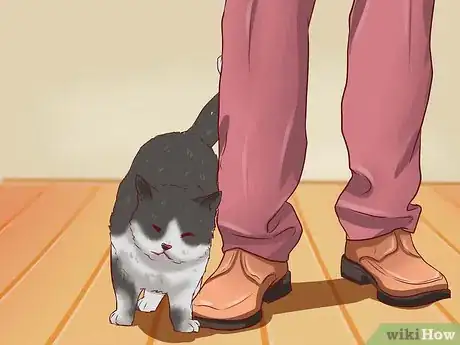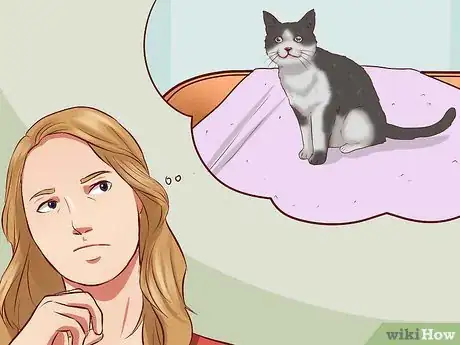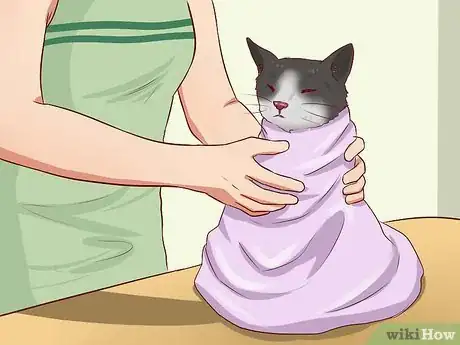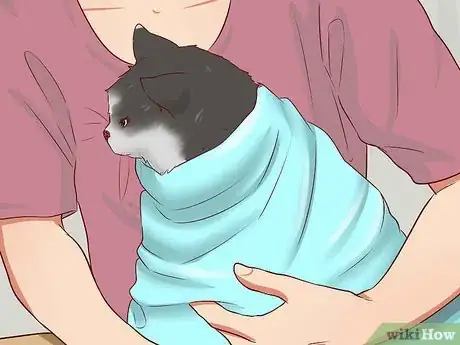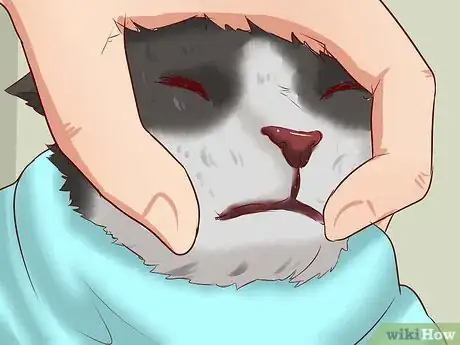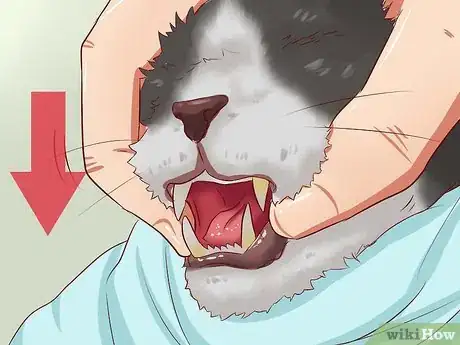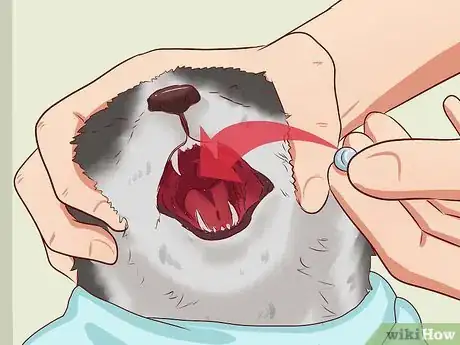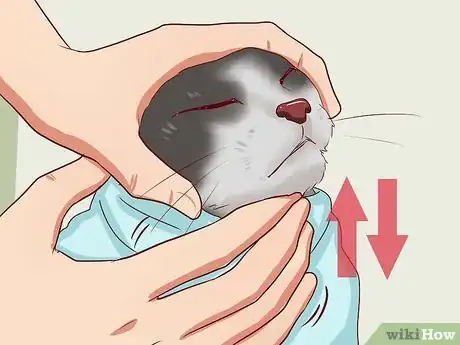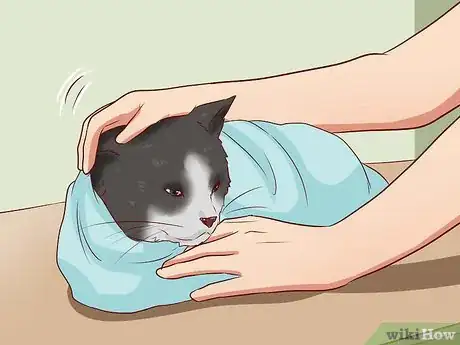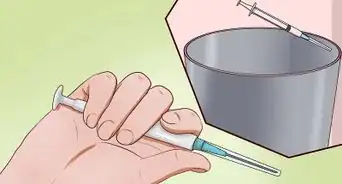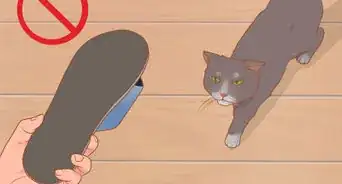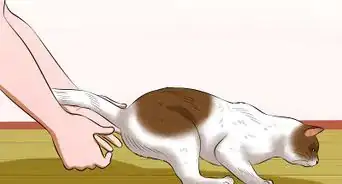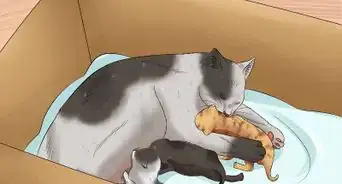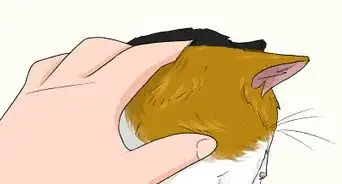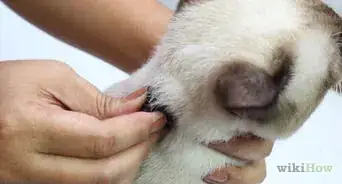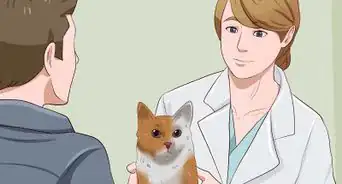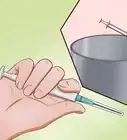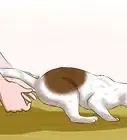This article was co-authored by Daniel Lioy-Ryan, PhD. Dr. Daniel Lioy-Ryan is an Animal Behaviorist and the Co-Founder of Cats in the City. With over a decade of experience, he specializes in understanding animal behavior, safely grooming cats, and working with cats at all life stages. Dr. Lioy-Ryan holds a PhD in Neuroscience from The Oregon Health & Science University.
wikiHow marks an article as reader-approved once it receives enough positive feedback. In this case, several readers have written to tell us that this article was helpful to them, earning it our reader-approved status.
This article has been viewed 240,264 times.
Most cat owners will need to open their cat’s mouth at some point. Cats do not generally enjoy the process and they will not open their mouths willingly in many cases. For instance, you may need to open a cat's mouth in order to administer a pill or some medication that the cat doesn't want to ingest. Because of this, the number one priority in opening a cat’s mouth is safety, for both you and your cat. Your cat's health is in your hands, so you owe it to him or her to treat it with care and safety in mind.[1]
Steps
Preparing to Open a Cat's Mouth
-
1
-
2Plan how you will position yourself and the cat. You need to think about where and how you will hold your cat and how and where you will hold any medications you are going to give it, if you are doing that. Ideally you will do this on a tabletop. Make sure there is nothing breakable nearby on the table, as your cat may break loose and knock things over.
- Place the towel or blanket on the table and spread it out. You will use the towel or blanket to wrap the cat up so it can't move.
- You will also want to have a syringe (without a needle attached) full of water on hand if you are giving your cat a pill. This will help to wash down the pill.
- Keep the pill in your more dexterous hand. Get your arms at the same height as your cat.
Advertisement -
3Put the cat in position and get it comfortable. Pick up the cat and place it in the middle of the towel, holding it down in a prone position on its belly. Bring one side of the towel up over the body, then bring the other side up over snugly. Bring the back end up towards the front making sure it’s snug.[4]
- Finally wrap the front of the towel around the cat’s back snugly. This should only leave the cat's head sticking out. Make sure the material is snugly wrapped around the cat in order to keep legs and claws inside the material.
- Try and calm the cat if it is fighting you. Some cats will put up with being wrapped up extremely well, while others will fight you tremendously. Gauge your specific cat and judge whether you can wrap it and calm it down or if you just need to wrap it up right before you open its mouth.
Making a Cat Open its Mouth
-
1Hold the cat steady on the table. If giving the cat medicine, hold the cat with your non-dominant hand while you pick up the medication with your dominant hand. If you have a helper, have them hold the wrapped cat for you. If you don’t, slide your elbow and forearm of your non-dominant hand alongside the cat’s wrapped body until you are holding it between your arm and your chest while the wrapped cat is still on the table.[5]
-
2Position your fingers. Put your thumb on one side and your forefinger on the other side of your cat's mouth along the cheeks where the jaw hinges.[6] You will be able to just barely be able to feel the teeth through the cheeks.
-
3Apply pressure gently until your cat opens its mouth by pressing down on the cat’s lower jaw until it opens its mouth. Basically you are pushing your fingers between the upper and lower jaw while applying slight downward pressure.[7] This pressure will be uncomfortable for the cat so it will open its mouth.
Giving a Cat Medication in its Mouth
-
1Insert any medicine into your cat's mouth while you have the mouth open. Using your pointer finger and thumb, put the pill toward the back of the mouth over the tongue in one quick movement. Then quickly withdraw your fingers so you don’t get bit. If you are worried about getting bit, you can purchase a pill popper that is like a long syringe with a plunger that you place the pill in and pass this into the cat’s mouth.[8]
- Don’t just shove a pill down the back of your cat’s throat. The pill could accidentally enter the cat’s windpipe, causing choking. Conversely, damage could be done to the back of the throat if the pill is forced down the esophagus.[9]
-
2Force your cat to swallow. Let go of the cat’s mouth and hold its top jaw or face so that its nose points upward. Rub your cat's throat gently to trigger the swallowing reflex.
- Use a syringe to place a small amount of water in the commissure between the lips to encourage the pill to “go down” the esophagus. This prevents the pill from irritating or “sticking” in the throat and damaging the tissues.
- DO NOT shoot the water down the back of the throat or the cat may inhale the water into its lungs.
-
3Maintain the same position for a few seconds before removing the covers and releasing your cat. You don't want your cat to injure itself while trying to get away, so you should try to calm it down before releasing it. Also, don't forget to give your cat a lot of praise and some tasty treats as a reward for good behavior.[10]
Expert Q&A
-
QuestionIs it good to brush your cat's teeth?
 Daniel Lioy-Ryan, PhDDr. Daniel Lioy-Ryan is an Animal Behaviorist and the Co-Founder of Cats in the City. With over a decade of experience, he specializes in understanding animal behavior, safely grooming cats, and working with cats at all life stages. Dr. Lioy-Ryan holds a PhD in Neuroscience from The Oregon Health & Science University.
Daniel Lioy-Ryan, PhDDr. Daniel Lioy-Ryan is an Animal Behaviorist and the Co-Founder of Cats in the City. With over a decade of experience, he specializes in understanding animal behavior, safely grooming cats, and working with cats at all life stages. Dr. Lioy-Ryan holds a PhD in Neuroscience from The Oregon Health & Science University.
Animal Behaviorist Yes it is! I brush cat's teeth all the time and the process is very straightforward.
Yes it is! I brush cat's teeth all the time and the process is very straightforward. -
QuestionHow do you use a toothbrush on a cat?
 Daniel Lioy-Ryan, PhDDr. Daniel Lioy-Ryan is an Animal Behaviorist and the Co-Founder of Cats in the City. With over a decade of experience, he specializes in understanding animal behavior, safely grooming cats, and working with cats at all life stages. Dr. Lioy-Ryan holds a PhD in Neuroscience from The Oregon Health & Science University.
Daniel Lioy-Ryan, PhDDr. Daniel Lioy-Ryan is an Animal Behaviorist and the Co-Founder of Cats in the City. With over a decade of experience, he specializes in understanding animal behavior, safely grooming cats, and working with cats at all life stages. Dr. Lioy-Ryan holds a PhD in Neuroscience from The Oregon Health & Science University.
Animal Behaviorist To brush a cat's teeth, you have to use the toothbrush to coax it to open its mouth. Start rubbing the brush alongside the corner of the cat's mouth. The kitty will open its lips a little bit, allowing the toothbrush to get on the external part of the teeth. Then, push the toothbrush a little further in their mouth, but not toward the throat.
To brush a cat's teeth, you have to use the toothbrush to coax it to open its mouth. Start rubbing the brush alongside the corner of the cat's mouth. The kitty will open its lips a little bit, allowing the toothbrush to get on the external part of the teeth. Then, push the toothbrush a little further in their mouth, but not toward the throat.
Warnings
- Practice makes perfect. Your cat may bite or scratch you, so wear long sleeves and pants to avoid injuries.⧼thumbs_response⧽
- It is very important to give your cat a little water immediately after you administer a pill to avoid harming your cat. If you don’t have a syringe you can try offering your cat a small amount of milk or water spiked with tuna water to drink.⧼thumbs_response⧽
- Rewarding is not just a superfluous step. It is important to reward your cat as fast as possible after doing this to make him/her more cooperative the next time you have to open its mouth for examination or to give medication.⧼thumbs_response⧽
Things You'll Need
- Towel or Small Blanket
- Pills
- Water
- Plastic Syringe
- Treats
References
- ↑ Guide to a Healthy Cat. Elaine Wexler-Mitchell. John Wiley & Sons. 2004
- ↑ Daniel Lioy-Ryan, PhD. Animal Behaviorist. Expert Interview. 17 August 2021.
- ↑ Cat Owner's Home Veterinary Handbook. Eldredge, D.M, Carlson, D.G, Carlson, L.D Giffin, J.M. John Wiley & Sons. 2008
- ↑ Cat Owner's Home Veterinary Handbook. Eldredge, D.M, Carlson, D.G, Carlson, L.D Giffin, J.M. John Wiley & Sons. 2008
- ↑ Cat Owner's Home Veterinary Handbook. Eldredge, D.M, Carlson, D.G, Carlson, L.D Giffin, J.M. John Wiley & Sons. 2008
- ↑ Daniel Lioy-Ryan, PhD. Animal Behaviorist. Expert Interview. 17 August 2021.
- ↑ Daniel Lioy-Ryan, PhD. Animal Behaviorist. Expert Interview. 17 August 2021.
- ↑ Guide to a Healthy Cat. Elaine Wexler-Mitchell. John Wiley & Sons. 2004
- ↑ Cat Owner's Home Veterinary Handbook. Eldredge, D.M, Carlson, D.G, Carlson, L.D Giffin, J.M. John Wiley & Sons. 2008
- ↑ Guide to a Healthy Cat. Elaine Wexler-Mitchell. John Wiley & Sons. 2004
About This Article
To open a cat’s mouth, pick a time when your cat is relaxed and happy, and wrap it snugly in a towel so that only its head is sticking out. Then, hold your cat steady as you put your thumb on one side of its mouth and your pointer finger on the other side, where its jaw hinges. After that, apply gentle downward pressure as you push your fingers between the upper and lower jaws, which will cause your cat to open its mouth. For more advice from our Veterinary reviewer, like how to give your cat medication once its mouth is open, read on!
